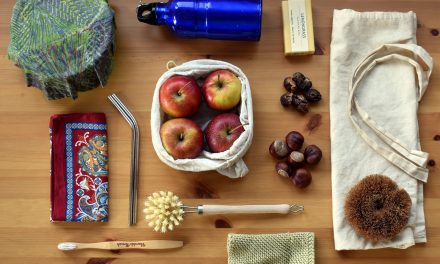Calling all East Sussex residents, release your inner ornithologist, because the Big Garden Bird Watch is back!
Simply choose one hour this weekend, between Friday 27 January and Sunday 29 January, to count the birds you see landing on your patch. Choose your own ‘patch’ – you don’t need to have a garden – it can be in a park.
Taking part is free, fun and for everyone. Your Birdwatch results help the Royal Society for the Protection of Birds (RSPB) monitor how our UK birds are faring in the face of the nature and climate emergency. But they need our support to gather some data!
The event is particularly important because results from previous years show that the decline in key bird species, that is being seen worldwide, is continuing in the UK too.
How to take part in Big Garden Birdwatch
Taking part is as easy:
- Get your Big Garden Birdwatch 2023 off to a flying start by signing up on the RSPB how to take part page. They’ll send you everything you need to take part. And sign up for their Big Garden Birdwatch emails to get expert advice on how to attract birds on to your patch.
- Choose one hour between Friday 27 and Sunday 29 January.
- Have a notebook and pen handy so you can collect the results – or download your free RSPB Big Garden Birdwatch guide, which has a helpful chart to help you identify the birds and record what you see.
- Select your ‘patch’ – your garden, your balcony, or in your local park.
- Watch the birds around you during that one hour.
- Count how the highest number of each species of bird lands on your patch – at any one time. For example, if you saw a group of four starlings, and towards the end of the hour you saw two starlings together, then record four as your final count.
- Remember to only count the birds that land – ignore the ones in flight – and try to avoid double counting.
- Then submit your results online, no later than 19 February – on the RSPB birdwatch page. Every single Birdwatch helps the RSPB learn more about how our birds are faring. So, wherever you are, whatever you saw – even if nothing at all – it all counts!
And tell us what you saw in the comments below.
By taking part in Big Garden Birdwatch you, and hundreds of thousands of other like-minded nature lovers, will be taking action to protect our birds for generations to come.
You don’t need to be an RSPB member to take part and if you’re a teacher, you can inspire your students with RSPB’s Big Schools’ Birdwatch.
Last year you helped put East Sussex on the ornithological map by taking part in the RSPB’s Big Garden Birdwatch. See the top 10 birdwatch results for East Sussex from last year, January 2022.
Good for mental health
Watching the birds in your garden, on your balcony, or just from a window, can be much more than a bit of fun getting back to nature. It’s also a brilliant way of slowing down and appreciating the beauty of wildlife and can be great for our mental health.
So, if you’re going to do your bit to make sure East Sussex is on the Big Garden Birdwatch map for 2023 – here’s what should you look out for, and how can you encourage our feathered friends to your patch.
Make them welcome
If you provide for the birds, they will come – especially at this time of year when they’re busy spotting sources of food and potential nesting spots. If you have garden space put out some feeders with seeds, suet, fruit, peanuts (not salted), meal worms etc.
And you can have a lot of fun making your very own bird feeders out of recycled bits and pieces. The National Trust has a brilliant guide with some super ideas: How to make a recycled bird feeder.
But also put food out on the floor – not all birds will flock to your feeders. Blackbirds, thrushes, and dunnocks, for example, are much happier feeding on the floor and will rarely attempt grabbing a quick meal at a feeder.
And if you don’t have a garden or balcony space, you could always try one of those see-through feeders that attaches to a window with a suction cap. I’ve put one up – positioned so the squirrels can’t jump on it (as they did at first) and am so thrilled when someone nips in quickly to take a few seeds. So far I’ve seen my garden robin dash in for a beak-full and a dunnock.
And don’t forget water. Birds need to drink, too. You don’t need a fancy bird bath, but just something with a bit of fresh water in it. And if you put up some nesting boxes, you may find the birds love your space so much they move in!
Bird-spotting
If you have a garden, you might prefer to sit somewhere comfortable indoors where you have a good view of the feeders or the space you’re observing. Try to be as inconspicuous as possible and try to keep still, avoiding any sudden movements. The less the birds sense danger, the more comfortable they will be visiting your space.
If you’re outdoors, maybe find a park bench – take a cushion and a hot water bottle and get cosy for an hour.
You may know the common garden birds but even if you do, try to have a bird book close to hand. If you don’t have one, the RSPB has a useful online British Bird Identifier. You may only spot the more common birds, or you may see something a bit more unusual.
If you can’t identify the bird at first make a note of its colour, size, any unusual colours on its head or wings, and the type of beak it has. And is it on its own or in a group? These will all help you as you try to figure out later what it was. Incidentally, while it may sound odd to also look at the colour of their legs, sometimes this can be a clue. For example, if you see a seagull look at its leg colour – if they’re yellow-green it’s likely to be a common gull, if they’re pink it’ll be a herring gull.
The Sussex Wildlife has put together a brilliant guide to watching and spotting birds. It tells you everything you might need to know.
Listen out for bird calls
Here are some mnemonics – onomatopoeic phrases or reminders – to help you identify some birds:
- The great tit‘s ‘teacher teacher’ call is easy to recognise
- The woodpigeon makes a beautiful cooing, sounding like ‘my toe bleeds, Betty’ – a bit macabre, but I can’t forget it
- The collared dove song is rather simpler than the woodpigeon’s. It’s a bit like a football fan chanting ‘un-it-ed, un-it-ed, un-it-ed’
- The yellowhammer‘s tune is thought to sound like someone saying ‘a little bit of bread and no cheeeeese’
- Barn Owl – ‘screeeeeee’
- Magpie – they always remind me of an old fashioned football rattle
- Lesser whitethroat – ‘lesser lesser lesser lesser whitethroat’ (very fast)
- Pied wagtail – ‘Chiswick flyover’
- Chiff chaff – ‘Chiffchaff’
- Kittiwake – ‘kitty-waaak’
- Jay – ‘jay-jay-jay’
- House sparrow – ‘chiddik chiddik’
Do you know any more? Please comment below.
What birds to look out for
Sparrow

The humble house sparrow is most likely to top your list. Look out for the darker brown markings of the male bird, and the softer browns of the female. They often move about in family groups so don’t be surprised if they descend in numbers. They will quite happily use the feeders and also seem to like most food!
Dunnock

The house sparrow’s relative, the dunnock, is also sometimes called the hedge sparrow. It is more timid than its bolder cousin and is smaller and more delicate, with more grey around its neck and chest. It will eat from the floor, not the feeder, and can often be seen picking up the pieces under the feeders while its garden buddies get to work over head.
Robin
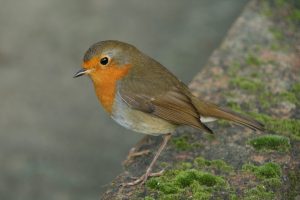
The robin is a British favourite and, as a Christmas card regular, often portrayed as the cute cuddly garden visitor. The truth, though, is a that beautiful little bird with its orange chest (both male and female have this) is actually a feisty feathered friend. It is fiercely territorial and can often be seen fighting off other robins from its patch. They are wonderfully inquisitive birds, however, and among the bolder of our garden visitors. I have a robin in my garden that often perches on my windowsill while I work and makes eye contact with me. The same bird often comes and joins me in the garden when I’m working outside. If you want to attract robins use dried mealworms – they love them.
Blue tits and Great tits
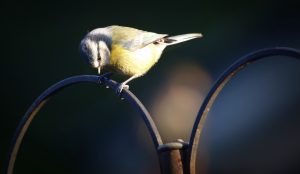
Tits are wonderful birds and you’re likely to see both blue tits – small, delicate birds with (yes, you guessed it) a blue cap and blue flashes on its wings, and its slightly bigger cousin, the great tit, with its handsome black cap, beard and stripe down its chest. If you’re lucky you may see a coal tit – not unlike the great tit but smaller and much less yellowy, or even a long tailed tit, a beautiful small fluffy white and grey bird with orangey red splashes and, yes, a longer tail. They will rarely be on their own, however. Tits will eat most seed, peanuts and suet, but to get them really excited, put out fresh coconut.
Starling

The starling gets a bad press. To be fair, it is the slightly thuggish of our garden birds and moves around in boisterous gangs. Although a ground bird it is highly adaptable though not always very delicate so don’t be surprised to see them flocking around your feeders and making a real mess. If you see them close up you’ll see they aren’t the dull dark grey birds so many dismiss them as. They have marvellous markings and colours and, with a bit of well-placed sunshine, shine magnificently. They are larger than the sparrows, robins and tits so can boss about their garden companions.
Blackbird
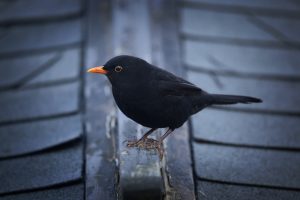
The serene king of the garden birds has to be the blackbird. Again, the big clue to spotting it is in its name. Dark matt black, the male has a distinctive orange beak. The female is less colourful and a soft brown colour. You won’t see a blackbird on a feeder but always generally on the floor. It much prefers worms and insects to any feed you put out, but will not say no to a discarded seed – normally cast down from the feeder by the chaotic squabbling starlings. In the spring the blackbird, with its warbly song, will often be the first bird you hear in the morning and the last you can listen to at night.
Song thrush

The song thrush, and its sibling the mistle thrush, are beautiful blackbird-size birds with creamy brown colourings and distinctive blotched markings on their chest. Again, the thrushes tend to be more timid. Put some feed on the floor and they’ll thank you.
Wren
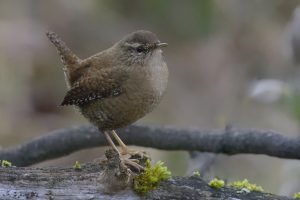
Our smallest regular garden bird is also one with the loudest most piercing song, though you’ll need to wait until spring to hear its amazing sound. The wren is easy to spot – smaller than the sparrows they are mainly a soft brown colour. But it’s their small up-turned tail that makes them easy to spot. They’ll eat most seeds but, again, prefer insects so check the hedges and small bushes where you might see them flitting from branch to branch.
Woodpigeon

One bird that has increased significantly in recent times is the woodpigeon. It’s larger and rounder than it’s feral relative the rock pigeon. With its grey colouring and pinkish chests, it’s quite a beautiful bird. They plod around the garden but often, amusingly, attempt to access the seeds in the feeders.
Finches
It used to be the case that you would be surprised not to see a finch or two in your garden. The green finch, sparrow-sized but yellowy green and with a powerful beak, was a regular. However, numbers have plummeted so if you’re lucky enough to see one, make sure you let the RSPB know. You may be lucky and see a family of goldfinches (they’re rarely alone) with their red faces and bright yellow wing flashes.
Magpie
Finally, a bird that is very much a double-edged sword. While the magpie is a strikingly handsome bird with its black and white plumage and blue stripe across its wings, it is also often the villain of the garden. Part of the crow family, the magpie will eat seeds and other food left out – but it’s also a predator and a scavenger. As such it can, and does, target the nests of other garden birds and will happily attack and predate the young.
More unusual birds
You might spot nuthatches (climbing up the trunk of a tree), woodpeckers, and even a fieldfare – a type of thrush rarely seen in gardens apart from in bad weather when access to their usual berries and feed is more difficult. And if you’re near a pond you might see a heron, though they obviously won’t be after your feeder food, they’ll be eyeing a fish supper in the water!
Birds are wonderful little creatures and they all have different behaviours and personalities. Some are shy, some are bold. Some are bullish, some timid.
I find it so hard to sit still, not look at my mobile. But this coming weekend – 27 to 29 January – I plan to allow myself an hour being quiet connecting with nature and wildlife.
Please comment below if you plan to record your own birdwatch, and especially if you completed one. We’d love to hear from you!
How to help wildlife in East Sussex
Find out how you can get involved by visiting the website of our featured wildlife and conservation organisation: Sussex Wildlife Trust. They have thousands of members who are helping them to protect the rich natural heritage of East and West Sussex, and Brighton and Hove. Their website is a treasure trove of photos and facts that will expand your knowldege and wellbeing that comes from connecting with nature in Sussex.
Look out for their introduction to birdwatching events which will take you to the woodlands, wetlands and coasts of Sussex to search for some of our fantastic birdlife. Their courses cover identification techniques, habitats, bird conservation and populations, migration and birdsong.
While you’re here
Are you struggling with the cost of living?
For money help and advice, help with benefits, household support, your health, transport and more, see Cost of living support | East Sussex County Council
Looking for employment?
We think East Sussex County Council is a great place to work. One of the most important things about working here is the knowledge that you’re working to help others and the real sense of achievement and purpose that brings. Find out what it’s like to work with us: Working here, pay and benefits | East Suussex County Council



